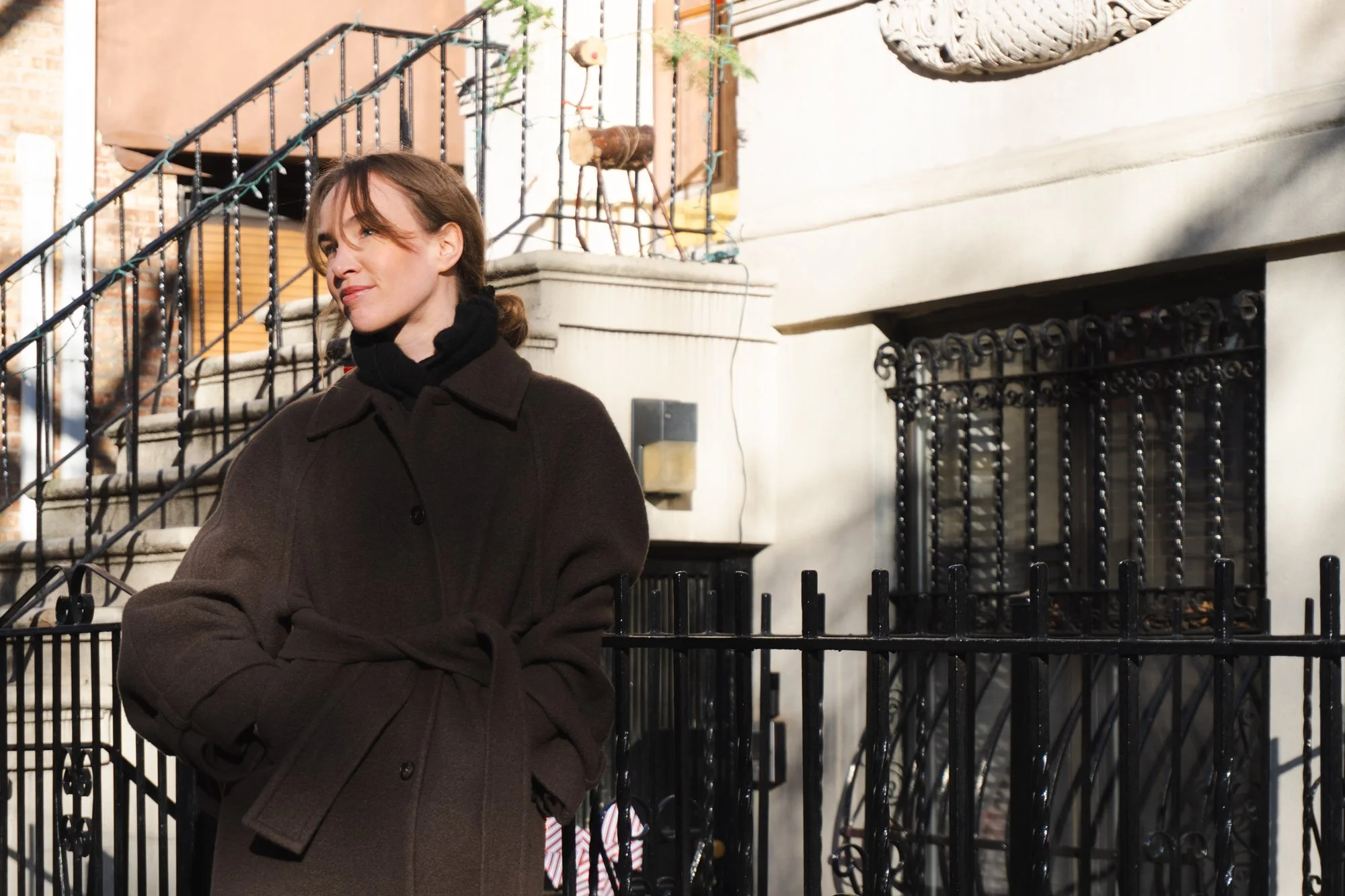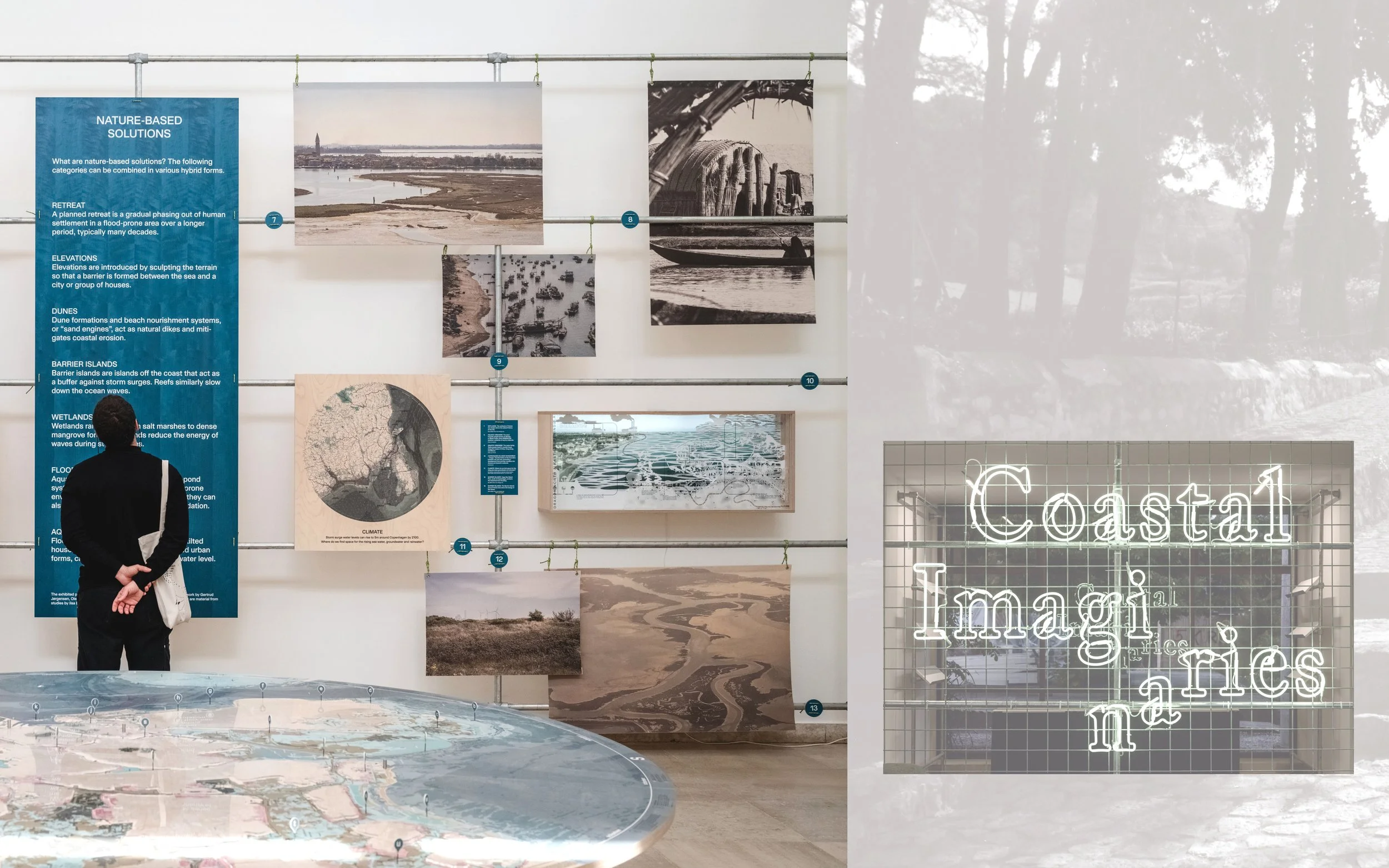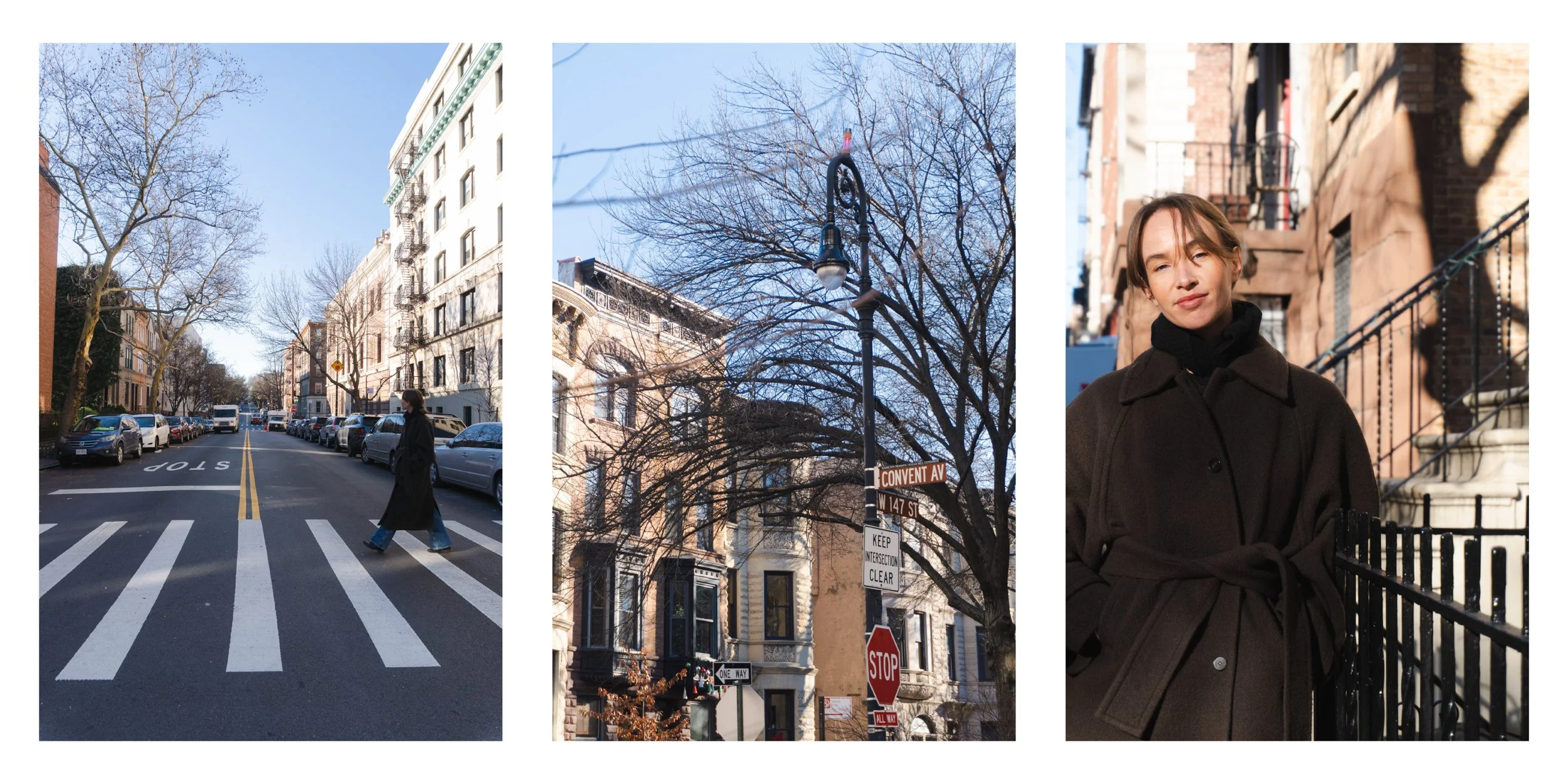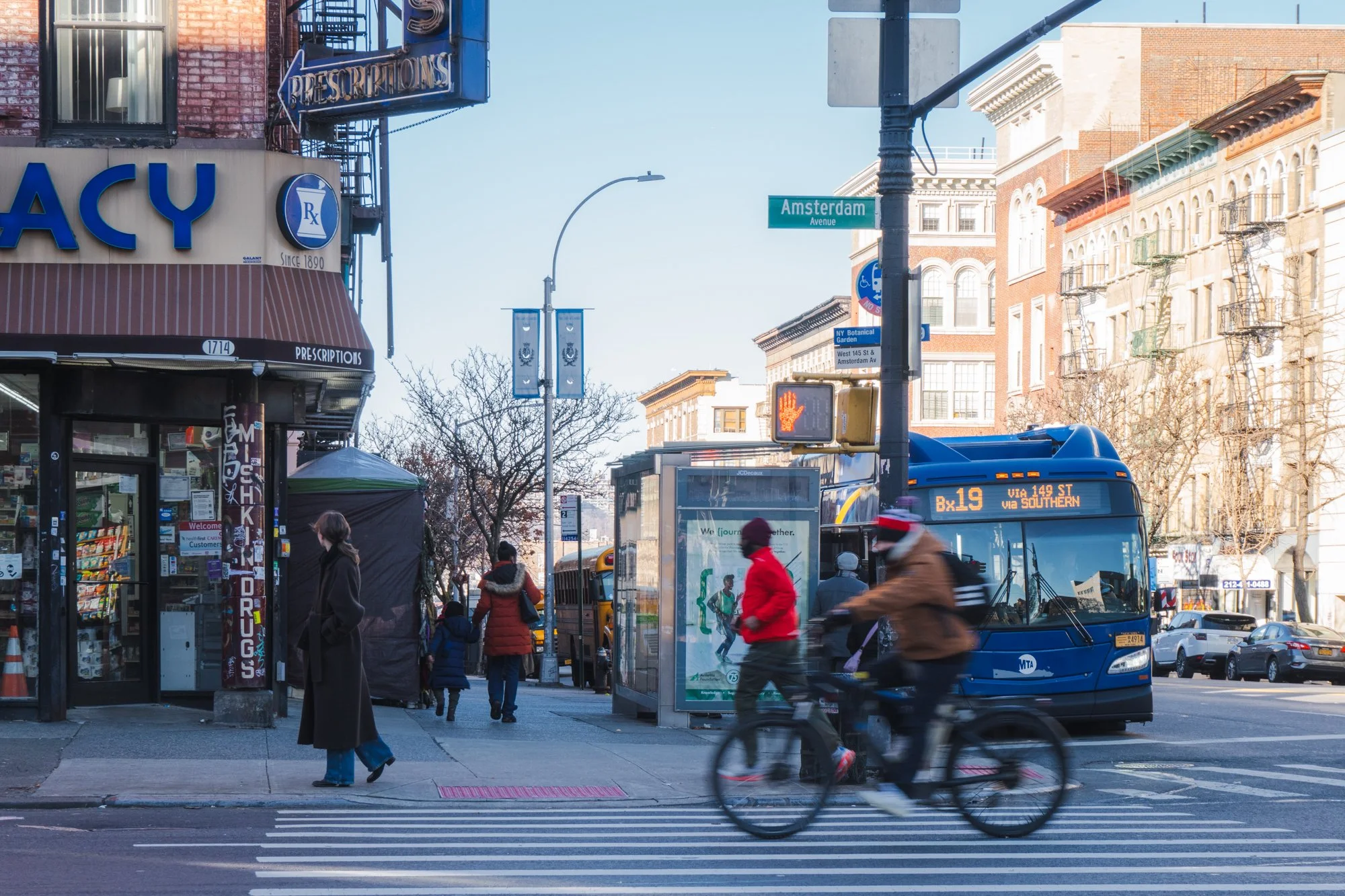2023
Iisa Eikaas on urban development and environmental change
Iisa Eikaas in Sugar Hill, Harlem. Photo: Laura Koskela
In collaboration with The Irwin S. Chanin School of Architecture, our Architect-in-Residence for the month of December, Iisa Eikaas, is a Finnish-Norwegian architect and researcher based in Copenhagen. Trained at the Royal Danish Academy and Aalto University, she is currently pursuing a Ph.D. in landscape architecture and planning at the University of Copenhagen.
Iisa’s research and design work explores the interactions of urban development and environmental change. By tracing the spatial and social impacts of climatic extremes, such as rising sea levels and stormwater floods, she examines how the dynamics of nature can be either harnessed or combated in urban planning. As a member of the Danish research group Mitigating Sea Level Rise and Åbo Akademi’s multidisciplinary research network The Sea she collaborates with anthropologists, engineers, and natural scientists in protecting coastal settlements from flood risks.
In her practice, Iisa strives to reconfigure symbiotic spatial systems inspired by the ecological knowledge of traditional communities. She has written about the topic in the newly published cross-disciplinary book Critical Coast and exhibited her work at the Danish Pavilion at Venice Architecture Biennale 2023. We wanted to know more about her and her time in New York, so we sent over a few questions for her to answer.
Can you tell us more about your architectural background and practice?
“I grew up in Finland, but I’ve lived abroad for the last seven years – mainly in Copenhagen, a year in Paris, and another in Rome. I suppose I’m as nomadic professionally as I am geographically, having dabbled in the design of diverse building types, green spaces, and urban areas. I have also been involved in a number of research projects, publications, exhibitions, and events.
I received a pretty pragmatic architectural education. Yet, early in my studies, I remember being fascinated by the complex social, cultural, and environmental dimensions of urban change. My first field studies in Vietnam, China, and Italy sparked my fascination for vernacular infrastructures and traditional livelihoods. Exploring their entanglements with modern urban development revealed chaotic and surprising connections. While I still greatly enjoy design, I developed a close affinity for the un-designed.
In recent years, I have specialized in nature-based water management and climate adaptation. I am currently working on my doctoral dissertation at the University of Copenhagen, where I explore resilient infrastructures for farming and aquaculture in flood-prone environments.”
"Coastal Imaginaries” exhibition at the Danish Pavilion, 18th International Architecture Exhibition – La Biennale di Venezia. Curated by Josephine Michau; pictured contributions by associate professor Anna Aslaug Lund, PhD fellow Iisa Eikaas, Schønherr Landscape Architects, and photographers Tor Eigeland and Lam Yik Fei. Documented by Rasmus Hjortshøj and Iisa Eikaas. 2023.
What sparked your interest in climate adaptation?
“Adaptation planning zooms into sites that are at the frontline of environmental destruction, compelling designers to radically rethink their spatial planning practices. In the last century, urban development has relied on technocratic means of controlling the dynamics of nature; building land out of water, constructing highrises on former wetlands, and piping and pumping lakes and rivers out of sight. But water has a way of returning to its origin; with increasing rain events and storm surges, rising seas and groundwater levels, about a third of the world population currently live in flood risk zones.
To me, climate change presents a challenge we can’t engineer our way out of – instead, spatial designers must tune in with the dynamics of nature, the forms of the terrain, and the cycles of wind and water. Our best cues for interpreting the landscape are often found in local, pre-modern building patterns and livelihood systems.”
Have you been able to find inspiration for your studies here in New York?
“Like much of the US, New York faces huge challenges with coastal climate adaptation. Rendered vulnerable by its lengthy coastline and low-lying geography, the metropolis struggles with adapting to rising seas and extreme weather events. While many new sea walls and dikes are under construction, I am particularly curious to learn about the nature-based adaptation projects in the area. Compelling examples include the New York cloudburst plan, which introduces new green spaces within the city grid to absorb rainwater, and the Living Breakwaters, off-shore oyster reefs that hinder storm surge and help purify the water.“
Photos: Laura Koskela
At the time of this interview, you have been in residency for about two weeks. What has been your main focus so far?
My first two weeks have been packed with meetings and events with fellow scientists, designers, environmentalists, and community activists. Although my research project isn’t directly linked to the local context, it has been fascinating to learn about the shared challenges in implementing nature-based adaptation measures in flood-prone cities.
At Columbia University, I got to meet with the Resilient Coastal Communities Project to discuss climate policy, democracy, and local engagement in adaptation planning. I also met a researcher from the New School who studies the challenges of coastal retreat as a response to frequent floods. At the New York Center for Architecture, I attended another talk, Future of Flooding, where similar concerns were raised about unsustainable and insufficient coastal protection plans. All the experts I talked to emphasized the urgent need for a multi-hazard assessment and the potential of nature in mitigating compound flood risks.
You’re also a visiting scholar at Cooper Union – have you had a chance to participate in the academic life at the institution?
December’s a hectic time for most academics and educators, but I’ve been thrilled to find how helpful and accommodating my American colleagues have been. I was welcomed by the dean at Cooper Union and got to participate as a guest critic in the final seminar of Lydia Kallipoliti’s course Environments. Students presented compelling and thoughtful projects in which they explored food systems, water cycles, and overlapping environmental and geopolitical crises. In stark contrast to Nordic – especially Finnish – architectural education, the students were encouraged to position their work to a larger societal and ecological context from the outset of their studies. As I prepare to teach courses myself, I will be inspired by my experiences in New York.
Speaking of New York, what are your reflections on your time here so far? Have these shifted from your initial expectations?
I first visited the city some eight years ago, and what struck me then still surprises me now: how grand it all seems from afar, yet somehow escapes closer inspection. The aura of the city, its magnificent skyline, and its vast influence in media, academia, and the art world seem to surpass what can be experienced first-hand. But there is a special appeal to the city life, as hard and hectic as it is. I live in a brownstone in Harlem, and I’ve become very fond of this area. Even in December, locals gather with their boomboxes blasting retro RnB hits, some D’Angelo here and there. Yesterday, I heard a juicy dancehall mix of Last Christmas by my bass-heavy next-door neighbor. It’s a great public service, really.
Strolling the streets of Sugar Hill. Photo: Laura Koskela
How will you spend your last weeks in the city, do you have any plans for the holidays?
One month is short, so I decided to make the most of it by staying in the city. As the universities close for Christmas, I look forward to touring the museums. First on my list will be MoMa’s exhibition Emerging Ecologies – Architecture and the Rise of Environmentalism.
I have also planned a few field trips to the flood-prone coasts of New York to explore how the city has evolved in the aftermath of Superstorm Sandy and many other flood events. The half-vacant neighborhoods in hurricane-hit districts speak of the precarity of living on these shores.
As a researcher, I feel like my profession is my hobby, and I hardly ever get to be entirely off work. Luckily, I have a few friends in the city to share a Christmas dinner with, and for New Year’s, we’re heading down south for a Californian forest retreat.
What is next for you after New York?
After the residency, I will continue my journey to Mexico for a few months of fieldwork on the Chinampa floating agriculture system. It’s a remnant of the Aztec-era predecessor of Mexico City, an ancient metropolis built on marshland divided by canals. The contemporary city was drained during the Spanish conquest and, like many other modern capitals, offers no place for water to flow. Thus, it suffers from recurrent, destructive floods. Although the Chinampas have diminished, this farming technique is still used intensively in some areas of Mexico City. It contributes to local food security and climate adaptation by absorbing rainwater from the surrounding residential area, exemplifying sustainable, integrated land use in a flood-prone region. I find it to be a promising case study in organizing spatial programs and livelihoods around local water systems.
In the midst of my fieldwork I will try to find the time to write a book chapter for an academic publication. And who knows what other projects I’ll manage to get myself into. I look forward to the warm weather in Central America, but I know I’ll soon be longing for the quiet of the Nordics.
Text: Nela Silfverberg



